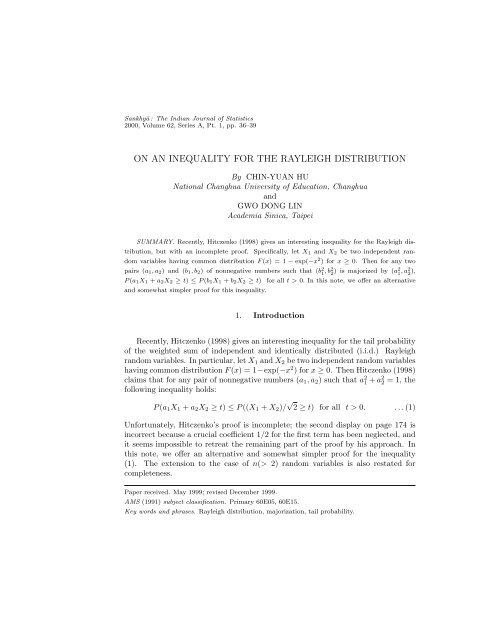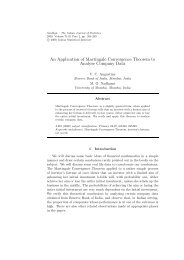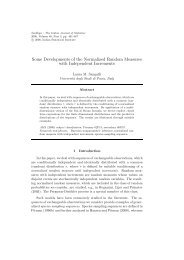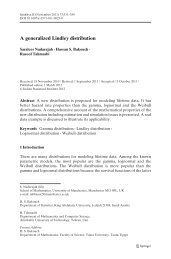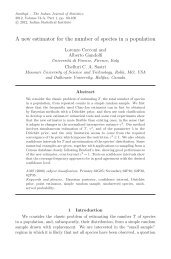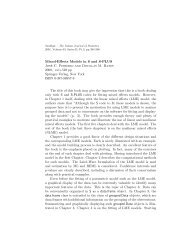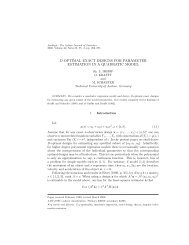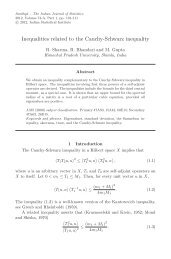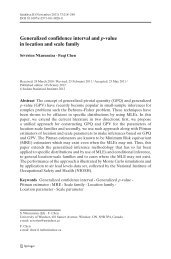Full paper (PDF) - Sankhya
Full paper (PDF) - Sankhya
Full paper (PDF) - Sankhya
Create successful ePaper yourself
Turn your PDF publications into a flip-book with our unique Google optimized e-Paper software.
Sankhyā : The Indian Journal of Statistics<br />
2000, Volume 62, Series A, Pt. 1, pp. 36–39<br />
ON AN INEQUALITY FOR THE RAYLEIGH DISTRIBUTION<br />
By CHIN-YUAN HU<br />
National Changhua University of Education, Changhua<br />
and<br />
GWO DONG LIN<br />
Academia Sinica, Taipei<br />
SUMMARY. Recently, Hitczenko (1998) gives an interesting inequality for the Rayleigh dis-<br />
tribution, but with an incomplete proof. Specifically, let X1 and X2 be two independent ran-<br />
dom variables having common distribution F (x) = 1 − exp(−x 2 ) for x ≥ 0. Then for any two<br />
pairs (a1, a2) and (b1, b2) of nonnegative numbers such that (b 2 1 , b2 2 ) is majorized by (a2 1 , a2 2 ),<br />
P (a1X1 + a2X2 ≥ t) ≤ P (b1X1 + b2X2 ≥ t) for all t > 0. In this note, we offer an alternative<br />
and somewhat simpler proof for this inequality.<br />
1. Introduction<br />
Recently, Hitczenko (1998) gives an interesting inequality for the tail probability<br />
of the weighted sum of independent and identically distributed (i.i.d.) Rayleigh<br />
random variables. In particular, let X1 and X2 be two independent random variables<br />
having common distribution F (x) = 1−exp(−x 2 ) for x ≥ 0. Then Hitczenko (1998)<br />
claims that for any pair of nonnegative numbers (a1, a2) such that a 2 1 + a 2 2 = 1, the<br />
following inequality holds:<br />
P (a1X1 + a2X2 ≥ t) ≤ P ((X1 + X2)/ √ 2 ≥ t) for all t > 0. . . . (1)<br />
Unfortunately, Hitczenko’s proof is incomplete; the second display on page 174 is<br />
incorrect because a crucial coefficient 1/2 for the first term has been neglected, and<br />
it seems impossible to retreat the remaining part of the proof by his approach. In<br />
this note, we offer an alternative and somewhat simpler proof for the inequality<br />
(1). The extension to the case of n(> 2) random variables is also restated for<br />
completeness.<br />
Paper received. May 1999; revised December 1999.<br />
AMS (1991) subject classification. Primary 60E05, 60E15.<br />
Key words and phrases. Rayleigh distribution, majorization, tail probability.
on an inequality for the rayleigh distribution 37<br />
2. The Main Result<br />
The main result is more general than the inequality (1) and is written in terms<br />
of majorization defined below.<br />
Let a = (a1, a2, · · · , an) and b = (b1, b2, · · · , bn) be two sequences of real numbers.<br />
Suppose that a1 ≥ a2 ≥ · · · ≥ an and b1 ≥ b2 ≥ · · · ≥ bn. Then we say that<br />
b is majorized by a, and denote b 0 and α ∈ [0, π/2],<br />
ht(α) ≡ P ((cosα)X1 + (sinα)X2 ≥ t) =<br />
π/2<br />
where φ ≡ φ(α, θ) = t/cos(α − θ) and θ ∈ (0, π/2).<br />
0<br />
sin(2θ)(1 + φ 2 )e −φ2<br />
dθ,<br />
Proof. Note that the joint density function of X1 and X2 is<br />
f(x1, x2) = 4x1x2e −(x2<br />
1 +x2<br />
2 )<br />
Therefore, for t > 0 and α ∈ [0, π/2],<br />
<br />
ht(α) =<br />
A<br />
for x1, x2 > 0.<br />
4x1x2e −(x2<br />
1 +x2<br />
2 ) dx1dx2, . . . (3)<br />
in which the set A = {(x1, x2) : (cosα)x1 + (sinα)x2 ≥ t, x1 > 0, x2 > 0}. By<br />
changing variables x1 = rcosθ, x2 = rsinθ, where r > 0 and θ ∈ (0, π/2), the set A
38 chin-yuan hu and gwo dong lin<br />
can be written as {(r, θ) : r ≥ φ(α, θ) = t/cos(α − θ), 0 < θ < π/2}, and the double<br />
integral (3) is equal to<br />
π/2<br />
0<br />
∞<br />
The proof is complete.<br />
φ<br />
2sin(2θ)r 3 e −r2<br />
drdθ =<br />
=<br />
π/2<br />
0<br />
π/2<br />
0<br />
2sin(2θ){− 1<br />
2 (1 + r2 )e −r2<br />
| ∞ φ }dθ<br />
sin(2θ)(1 + φ 2 )e −φ2<br />
dθ.<br />
Lemma 5. Let t > 0 and let ht be the function as defined in Lemma 4. Then<br />
the derivative h ′ t satisfies (a) h ′ t(α) ≥ 0 for α ∈ [0, π/4] and (b) h ′ t(α) ≤ 0 for<br />
α ∈ [π/4, π/2].<br />
Proof. (a) For α ∈ [0, π/4], by differentiating the function ht with respect to<br />
α and using Lemma 3, we have<br />
h ′ t(α) =<br />
=<br />
π/2<br />
0<br />
π/2<br />
0<br />
sin(2θ){ ∂<br />
∂α ((1 + φ2 )e −φ2<br />
)}dθ =<br />
2cos(2θ)(1+φ 2 )e −φ2<br />
dθ ≡<br />
π/2<br />
0<br />
k(θ)dθ =<br />
π/2<br />
0<br />
π/4<br />
0<br />
sin(2θ){− ∂<br />
∂θ ((1 + φ2 )e −φ2<br />
)}dθ<br />
k(θ)dθ+<br />
By a change of variables, the second integral I2 can be written as<br />
I2 = −<br />
π/4<br />
0<br />
2cos(2θ)(1 + ψ 2 )e −ψ2<br />
dθ,<br />
where ψ ≡ ψ(α, θ) = t/sin(α + θ). Therefore, we have<br />
h ′ t(α) =<br />
π/4<br />
2cos(2θ)[(1 + φ<br />
0<br />
2 )e −φ2<br />
π/2<br />
π/4<br />
k(θ)dθ ≡ I1+I2.<br />
− (1 + ψ 2 )e −ψ2<br />
]dθ, . . . (4)<br />
in which φ = φ(α, θ) ≤ ψ(α, θ) = ψ by Lemma 1. Hence the term in the square<br />
brackets of (4) is nonnegative due to Lemma 2. This implies that h ′ t(α) ≥ 0 for<br />
α ∈ [0, π/4].<br />
(b) For α ∈ [π/4, π/2], we have<br />
ht(π/2 − α) = P ((sinα)X1 + (cosα)X2 ≥ t) = P ((cosα)X1 + (sinα)X2 ≥ t) = ht(α),<br />
the second equality following from the fact that X1 and X2 are i.i.d. random<br />
variables. Therefore, for α ∈ [π/4, π/2], h ′ t(α) = −h ′ t(π/2 − α) ≤ 0 due to the result<br />
of part (a). This completes the proof.<br />
Proof of the theorem. By definition of the majorization, we have a 2 1 + a 2 2 =<br />
b 2 1 + b 2 2 ≡ c (say). For the case c = 0, both sides of the inequality (2) are equal to<br />
zero and nothing needs to prove. For the case c > 0, the inequality (2) is equivalent<br />
to<br />
P ((a1X1 + a2X2)/ √ c ≥ t) ≤ P ((b1X1 + b2X2)/ √ c ≥ t) for all t > 0,
on an inequality for the rayleigh distribution 39<br />
where (b2 1/c, b2 2/c) 0, the function gt by<br />
<br />
gt(a) = P aX1 + 1 − a2 <br />
X2 ≥ t for a ∈ [0, 1].<br />
Then it remains to prove that gt(a) decreases for a ∈ [1/ √ 2, 1]. Letting a = sinα,<br />
we rewrite the function gt in the form<br />
gt(a) = gt(sinα) = P ((sinα)X1 + (cosα)X2 ≥ t)<br />
= P ((cosα)X1 + (sinα)X2 ≥ t) = ht(α), α ∈ [0, π/2],<br />
so that h ′ t(α) = g ′ t(sinα)cosα = g ′ t(a) √ 1 − a 2 for α ∈ [0, π/2]. By Lemma 5(b), we<br />
have g ′ t(a) ≤ 0 for a ∈ [1/ √ 2, 1) because h ′ t(α) ≤ 0 for α ∈ [π/4, π/2]. This together<br />
with the continuity of gt implies that gt(a) decreases for a ∈ [1/ √ 2, 1]. The proof<br />
is complete.<br />
Applying the above theorem Hitczenko (1998, p. 172) further obtains a general<br />
result for n(> 2) random variables. We now restate the general result for<br />
completeness. Let X1, X2, · · · , Xn be n(> 2) independent random variables having<br />
common distribution F (x) = 1 − exp(−x 2 ) for x ≥ 0. Assume further that<br />
a = (a1, a2, · · · , an) and b = (b1, b2, · · · , bn) are two sequences of nonnegative num-<br />
bers such that (b2 1, b2 2, · · · , b2 n) ≡ b2 0.<br />
k=1<br />
k=1<br />
Acknowledgement. The authors would like to thank the referee for helpful comments.<br />
References<br />
Hitczenko, P. (1998). A note on a distribution of weighted sums of i.i.d. Rayleigh random<br />
variables. Sankhyā, Series A, 60, 171-175.<br />
Marshall, A. W. and Olkin, I. (1979). Inequalities: Theory of Majorization and Its Applications.<br />
Academic Press, New York.<br />
Chin-Yuan Hu<br />
Department of Business Education<br />
National Changhua University of Education<br />
Changhua 50058, Taiwan, Republic of China<br />
Gwo Dong Lin<br />
Institute of Statistical Science<br />
Academia Sinica, Taipei 11529<br />
Taiwan, Republic of China<br />
e-mail : gdlin@stat.sinica.edu.tw


